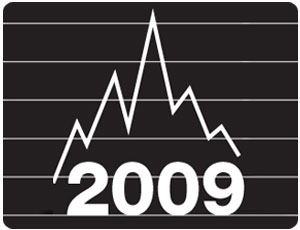Recession KO’s Inflation in 2009
Inflation had its last hurrah during the first half of this year and it was quite impressive with both steel and oil prices soaring to record levels despite a subprime mortgage crisis that was destroying the housing industry. But then the Fat Lady sang and the full extent of the financial crisis started to reveal itself. With banks, insurance companies, Wall Street investment firms and the automotive industry all lining up for bailouts, commodity prices started to tumble. Oil prices fell from over $140 per barrel to less than $70. Steel prices also started to head down and economists expect them to keep falling through most of next year. Unemployment started to soar, and will undermine wage negotiations next year. To make matters worse, the problem is worldwide with Asia, Europe, the Middle East and Latin America all struggling. Demand is drying up and that is driving prices down.

With that dismal backdrop, ENR predicts that its Building Cost Index, after rising 5.3% this year, will post a rare 0.5% decline in 2009 as steel, lumber and cement prices all fall. However, materials only make up 20% of ENR’s Construction Cost Index. As a result, the CCI is projected to increase 1.2% by the end of next year, after climbing 5.7% in 2008.
These two trends point out the importance of labor costs in forecasting ENR’s indexes. Union wage rates, including fringes, account for 80% of the CCI and 65% of the BCI. A year ago, ENR’s forecast called for a 4.3% increase in the BCI’s skilled-labor component and a 4.7% increase in the CCI’s laborers component. The actual increase was 4.0% for skilled labor and 5.2% for laborers among ENR’s 20 cities.
Multiyear collective bargaining agreements are usually a good benchmark for predicting the following year’s wage trends. This year that indicator is a bit murky. The Construction Labor Research Council, Washington. D.C., reports this year the average union wage for bricklayers increased 3.6%, while that for carpenters increased 5.0%. However, CLRC says there are “too few agreements to show a meaningful average for 2009” for skilled workers. On average, laborers in multiyear contracts have negotiated a 4.7% increase for next year.
But with unemployment soaring, union locals entering into negotiations in 2009 will be hard pressed to match those gains. In November, the U.S. Dept. of Labor reported construction’s unemployment rate was 12.7%, more than double what it was a year ago. ENR believes that situation will dampen wage pressure and is forecasting labor costs to increase between 3.5% and 3.7% next year.
Commodity Prices Collapse
The materials component of both ENR cost indexes consists of lumber, cement and structural steel. Prices for all three are forecast to decline in 2009. The most significant swing will come from steel prices, which account for 22% of the BCI and 13% of the CCI.
“It’s safe to say that the only direction for steel in the next six months is down,” says John Mothersole, an economist with Washington, D.C.-based forecasting firm IHS Global Insight. Structural-steel prices peaked in the third quarter of this year at $1,094 a ton, which was $465 higher than the third quarter of 2007. However, the rapid deterioration in both the domestic and global markets, especially demand for scrap metal from China, has pushed structural-steel prices back 15% this quarter, says Mothersole. He predicts prices will decline another 20% by the second quarter of next year before firming.
“A lot of capacity is being pulled offline and that will help form a bottom for steel prices,” Mothersole notes. “And with all the stimulus being pumped into the global economy prices could snap back quicker than anticipated.”
However, Global Insight’s prediction is for prices to remain weak through 2010. “The nonresidential building market is starting to falter and we don’t see that making a quick comeback,” says Mothersole. ENR’s forecast calls for structural-steel prices to decline 10.3% by next December.
The Portland Cement Association, Skokie, Ill., estimates that total cement consumption will decline 12.8% this year. Producers so far have been able blunt the downward pressure on prices by drastically cutting back on imports. In October, the producer price index for cement was down just 1.9% from a year ago. Producers are unlikely to maintain this discipline next year when PCA predicts another 11.9% decline in consumption. As a result, ENR’s forecast calls for cement prices to decline 1.7% next year, while Global Insight sees a 2.3% decline.
Next year is going to be another dismal one for housing, with Global Insight predicting starts to fall as low as 700,000. This will keep lumber prices low but there is not much more room for them to decline, says Paul Janke, economist with Bedford, Mass.-based forecasting firm RISI. “If prices stay where they are much longer we are going to see massive mill closures,” he says. That would cut production by 10% next year. ENR’s forecast calls for lumber prices to fall another 3.5% next year.


.png?height=200&t=1720641768&width=200)
